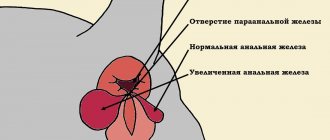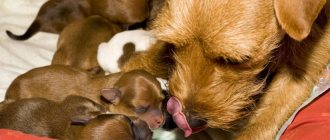Swelling of the mammary glands in dogs is a visible sign of inflammation, which can be caused by various factors. This does not always mean that a female dog is sick, as her breasts increase in size during heat, pregnancy and nursing, which are natural phases that a female dog may experience. But inflammation of the mammary gland can also be associated with certain pathologies, such as canine mastitis.
Does your dog have swollen mammary glands? Remember to always consult with a trusted veterinarian to rule out any pathological cause and check the health of your furry dog. However, in this article, we will help you understand why your dog's mammary glands are swollen by presenting the most common causes and treatment options.
The main causes of swollen mammary glands
- Swollen mammary glands in bitches during heat
- Pregnancy and breastfeeding
- psychological pregnancy
- Inflamed mammary glands from allergies
- Trauma or accidents
- Swollen mammary glands in bitches due to mastitis
- Neoplasms and breast cyst
Here we have listed the 7 most common reasons, now let’s talk in more detail about each of them so that you understand what’s wrong with your dog and know how to act in a situation where your dog’s mammary glands are swollen.
© shutterstock
How to avoid the difficulties of estrus
To cope with the symptoms of estrus in dogs, breeders and dog owners advise using drugs to regulate sexual heat.
Drugs from the CounterSex Neo brand are hormonal drugs for regulating sexual desire and preventing unwanted pregnancy in case of accidental mating.
Many breeders and dog owners use CounterSex Neo for the following reasons:
- High efficiency. With the help of CounterSex Neo drugs, it is possible to effectively correct a dog’s behavior, solve problems of aggression, marks in dogs during heat; prevent unwanted pregnancy.
- Safety. CounterSex Neo is a new generation bihormonal drug. The drug is safe due to the minimal content of 2 modern active ingredients.
- Convenience. The drug CounterSex Neo is available in the form of drops and tablets. Each owner can choose the most comfortable form of the drug for his dog, in which it will be convenient for him to give the drug to the animal.
Pregnancy and breastfeeding
If your dog had sex with a male during her last breeding season, her swollen mammary glands could be a sign of pregnancy . Female mammals experience major hormonal changes during gestation, which prepares them for childbirth and lactation. As pregnancy progresses, bitches' breasts swell and enlarge to provide milk, and their bellies enlarge to support the growth of their puppies.
A pregnant dog should undergo medical monitoring throughout pregnancy. It is also important to offer her a special diet, high in calories and high quality protein, as well as all the necessary measures to keep her and her puppies healthy.
When it's time to give birth, your furry friend will be physically and mentally ready to feed her pups. During lactation, your dog's mammary glands swell and enlarge, but this condition improves as weaning approaches. Many bitches never regain their original breast size after becoming a mother. In general, the nipples are larger and more flaccid than those of bitches who have never been pregnant.
Step-by-step passage of heat
The entire animal cycle is divided into 4 stages:
- Proestrus (or called proestrus). Duration 1-1.5 weeks. At this time, the process of blood circulation in the genital area increases significantly, the loop swells, and the first, initially scanty, bloody discharge appears. During this period, the dog is not yet ready for mating; ovulation has not yet occurred. But external signs are already evident - she becomes playful, may not obey the owner, and run away. When walking, he spends more time sniffing out the surroundings and constantly crouches down to leave marks. Males are already experiencing increased interest; when trying to copulate, the bitch growls and snarls.
- Estrus (active sexual hunting). During this period of time, more precisely the first 2 days, the process of ovulation occurs. But the bitch can keep the gentlemen away for a few more days. A little later, when she sees a potential suitor, the female raises the back of her body, tightens the noose and moves her tail to the side to facilitate the penetration process. She freezes and patiently waits for action from the male dog. The discharge from the loop will vary; normally, the appropriate period for mating occurs when it is light pink or disappears completely. The vulva swells significantly.
- Metaestrus (the final stage of estrus). The duration of this period is several days. The discharge stops, the noose returns to its previous size, and the bitch again does not allow gentlemen to approach her. If fertilization does not occur, then the female again becomes calm. The dog still experiences hormonal changes - the level of progesterone increases, which is not without reason called the pregnancy hormone. This happens regardless of whether the female becomes pregnant or not. This condition becomes the cause of such a phenomenon as false pregnancy, which mostly passes without outside help and consequences.
- Anestrus (phase of sexual tranquility). The duration of this stage is approximately 100-150 days and allows the animal’s body to recover before the next heat.
The frequency of estrus varies among dogs due to several associated factors. For example, in domestic dogs it happens 2 times a year - in autumn and at the end of winter. Sometimes flow is limited to once a year.
Dogs that are kept outdoors, pets from the north, breed once a year in early spring to give birth to puppies in the warmer months.
Psychological pregnancy
False pregnancy (or psychological pregnancy) is very common among fertile dogs. In general, the picture appears when a female has had sexual contact with a male, but fertilization has not been completed. However, pregnancy can develop without prior mating.
The symptoms of psychological pregnancy are almost identical to the symptoms of real pregnancy: the bitch has swollen mammary glands, the belly and nipples increase in size, and their appetite increases. They also usually produce and pass through the breasts whey, which is lighter and thinner than breast milk. Therefore, it is not surprising to observe a bitch with swollen mammary glands after estrus, and also to see that the bitch has milk and is not pregnant. To prevent this from happening, the best option is sterilization, since long-term psychological pregnancy can lead to serious health problems.
© shutterstock
A little more about estrus and what happens after
After a while, I realize that I didn’t tell everything about the heat. I was probably in too much of a hurry to write about the rut. Therefore, here are a few facts that - I hope - will help you understand and survive this difficult period.
The first heat may appear without any predecessors, be hidden, short and at the wrong time. Do not judge by the first heat how subsequent ones will proceed. However, if the first heat is a full-fledged one - for a long time, with discharge, a swollen loop and pestering by inopportune males - I recommend recording it. Mark:
1. the date of the start of estrus 2. on what day the bleeding disappeared 3. when the bitch began to move her tail to the side (they do this if you touch the croup or hair between the anus and the loop) 4. when the bitch began to get nervous and want to go outside (such It doesn’t happen to everyone, but it’s better to be on guard) 5. end date of estrus
pp. 2-4 mark the most dangerous period. Usually the appearance of these signs means that in 2-3 days the bitch will be ready for mating. These deadlines are very individual. There are those who mate on the 11th day of estrus. For many, this is days 14-17. My Ellie successfully mated of her own accord from the 21st to the 23rd day of her heat - this is not typical, but this is her physiology.
The bitch usually prepares for a full-fledged heat in advance. Frequent signs of preparation for heat:
1. The dog marks the territory (often pees, sometimes even lifting its paw; it marks other people’s marks). 2. The dog becomes nervous and aggressive, almost indiscriminately, even towards puppies (especially puppies! Be careful!). The reason is that the dog is preparing to become a mother and is clearing the territory for her future children. Eliminates competitors. Here is a striking example. The other day Ellie met her daughter Sheri. They are actually good friends (in the photo in the header of the post - Sheri, Ellie and Fly). But now both are preparing for heat, so when they met, they raised their mohawks, sniffed on tense paws and growled. And these are best friends, mother and daughter! Then, however, they calmed down and went for a walk together. But if there had been another dog in the friend’s place, they would have fought right away. 3. Often estrus is preceded by molting.
During heat, a bitch is often aggressive towards all dogs, except those in whom she sees the potential father of her puppies. And also provokes aggression from other bitches. This is another reason to walk separately.
After the first heat, the bitch’s mammary glands begin to develop , they swell and thicken. However, there should be no inflammation, no redness, much less milk production - this is a pathology and requires contacting a veterinarian.
And one more entertainment that awaits you after estrus - false pregnancy . It doesn't happen to all dogs. But it's worth knowing about it. And an important point - it happens very often in Basenji bitches. So often that it is better to take measures to prevent “falsehood” immediately after estrus (measures are discussed below). This is another legacy of wild ancestors. Puppies are a great value. If their mother dies, other bitches who do not have puppies will be able to feed the babies. False pregnancy is the reason why the bitch’s character deteriorates sharply after estrus. Well, naturally - she’s getting ready to give birth, and there are so many enemies in the world! Everyone must at least be driven away from the lair. Former dog friends become competitors for food and territory. And again, in Basenjis, as “uncivilized” dogs, this is expressed very clearly. 1.5-2 months after the end of her heat, the bitch begins to look for a secluded den. For example, my giant schnauzer Gerda tried to crawl under the table or chair. A dog may whine a lot. Another clear sign is digging. This is when the uterus contracts and the bitch begins to build a nest. Sometimes she sneaks toys there. Cases have been described when a dog began to go crazy over squeaking toys, associating them with the squeaking of puppies. The nipples swell and if you miss the moment, milk will come out. This is already very bad, this is an advanced situation, fraught with mastitis. There are many drugs that help relieve pathological symptoms. But it’s better not to let it come to that. Therefore, if you have a Basenji girl, or if you know your dog is prone to false pregnancy, immediately after the end of the heat, put the dog into the “eat little, work hard” mode. Cut the ration by a quarter and give the dog active, regular exercise. Muscular and mental. In this mode, “false veins” practically do not develop, and the hormonal levels quickly stabilize.
Lyudmila Amarantova
citidog.online
Inflamed mammary glands from allergies
Allergies are abnormal or exaggerated immune reactions that the body develops after exposure to certain substances, foods, hormones, or pathogens. This reaction triggers an inflammatory process that can manifest itself locally or spread to other parts of the body, and can also affect the respiratory system.
If you used a new hygiene product, it is possible that her mammary glands became swollen due to an allergic reaction. Also, flea bites, certain medications and natural substances such as pollen or mold can cause more intense allergies in sensitive areas such as the chest, eyes and ears. If this is true, your dog may feel very itchy and try to scratch or lick the belly very hard. In both cases, it is important to stop eating either product and take your dog to the vet for some allergy testing.
No heat
With good general health and the state of the reproductive and hormonal systems, the first estrus occurs at the established normal times and then repeats with a certain cyclical regularity. If the dog is older than 18 months, and the first heat has not come, you should consult a veterinarian to find out the reason for this delay.
Reasons for delay/absence of first heat:
- Poor living conditions, improper or insufficient feeding;
- Violation of hormonal regulation of the reproductive system;
- Congenital disorders in the development and structure of the genital organs;
- Ovarian dysfunction (hypofunction, lack of appropriate hormones during the appropriate period);
- Dysfunction of the pituitary gland and/or thyroid gland;
- Tumors and/or other neoplasms, cysts of the pelvic organs or on the ovaries;
- Endocrine pathologies;
- Chronic inflammatory processes in the uterus;
- Hermaphroditism (for example, when underdeveloped testes are found instead of ovaries).
Trauma or accidents
If your dog has been in an accident or has recently been kicked, his chest may be swollen due to the injury. This is a natural process that allows the damaged area to recover. In this case, only some bitches are likely to swell, since the blow usually causes an actual reaction. You may also notice bruising or injury near the swollen area.
Again, we remember that it is very important to take your dog to the vet to check his health after a stroke or accident.
Prevention
To prevent mastitis in bitches, follow these steps:
- provide comfortable living conditions: the den should not be dirty, cold or too hot;
- regularly treat the bitch against ectoparasites, worms, vaccinate in accordance with the vaccination plan;
- choose a partner for mating who is free from sexually transmitted infections;
- For whelping and lactating bitches, give plenty of ready-made food mixture for puppies, so it will be easier for babies to switch to solid food;
- if there are few cubs and the female’s milk production is high, temporarily switch her to a low-calorie veterinary diet for obese dogs;
- Avoid using hormonal contraceptives to prevent estrus, as well as to terminate an unwanted pregnancy;
- animals in which imaginary pregnancy has recurred are not recommended for use in purebred breeding;
- bitches that are not of breeding value are castrated before puberty;
- Inspect the udder of a lactating uterus regularly and sanitize if microtraumas are detected.
Watch the video:
Swollen mammary glands through mastitis
Mastitis is an infectious process that affects the breasts of bitches in a very similar way, causing visible inflammation of their nipples. In addition to swelling in the mammary glands, affected females usually have severe tenderness and pain when touching the breasts, with the presence of purulent discharge.
Mastitis usually appears at the end of lactation or after a pseudo-pregnancy that has not been properly treated. The condition progresses quickly and seriously affects the dog's health, requiring immediate medical attention. Additionally, it is important to prevent mastitis by offering proper care during pregnancy or when a psychological pregnancy is diagnosed.
Symptoms of the disease: danger signs
Sometimes, if a dog has enlarged nipples, this is a sign of a tumor. If your pet has dense body hair, it will be much more difficult to notice symptoms. Most often, a doctor is consulted if the owner feels a lump in the animal’s abdominal area. This can be observed more in older females, but similar cases can also be found in young individuals. At the last stages, the tumors are larger than at the beginning.
In addition, when touched, you can feel an increased temperature in the nipples. They will release a clear, red or yellow liquid. If treatment or recognition is delayed, the nipples may begin to fester and scars will appear.
Neoplasms and breast cyst
If you feel lumps or strange masses when you touch your dog's chest, you should contact your veterinarian immediately. Abnormal palpation of a bitch's chest usually reveals a mammary cyst or tumor, which may be a symptom of cancer. In both cases, immediate medical attention is required to conduct adequate research and early diagnosis of the presence of malignant tumors. Remember that early diagnosis of breast cancer usually improves the prognosis of the disease.
© shutterstock
Symptoms of mastitis in dogs
Mastitis is one of the extreme cases where swollen nipples become dangerous for animals. In order to notice the disease in time, it is necessary to promptly pay attention to certain symptoms:
- the skin of the mammary gland thickens and begins to swell and may turn blue;
- nipples become painful;
- the skin begins to turn red.
The longer mastitis is left untreated, the worse it becomes for the female. The pet's body temperature rises, the nipples begin to fester. The mother does not allow the children access to the nipples and breast milk. She is in pain, her chest is swollen and painful.
Important! If everything goes to extremes, an abscess begins and it can lead to gangrene and necrosis.
Timely help will help save the dog
Diagnostics
As we've noticed, if your dog has swollen mammary glands, the most important thing is to see a veterinarian as quickly as possible. This way, this specialist will be able to review her, run all the necessary tests and provide you with a report and diagnosis of her health status, as well as the possible treatments available in each case.
Typically, to diagnose this situation, a specialist asks the following questions and tests::
- When was the dog's last heat?
- Physical examination, with palpation.
- Will take a sample of the fluid, if any, for testing.
- Blood analysis.
- Analysis of urine.
- X-ray and ultrasound.
When to see a doctor
Is there a heat after sterilization in dogs?
If your dog's mammary glands begin to swell, you should not immediately worry. A veterinarian's consultation will be required in the following cases:
- The symptoms of a false pregnancy did not go away after three weeks. The dog will need to undergo a thorough examination. She may need hormone therapy. Only a doctor can prescribe medications and treatment regimens.
- The animal's nipples may turn blue. This suggests that mastitis has begun against the background of a protracted false pregnancy. As a treatment, you can lubricate the papillae with camphor oil. Compresses help a lot. It is important that the dog's access to the nipples is blocked during the process. To do this, the pet's belly is tied with an elastic bandage.
False pregnancy itself is not considered a pathology. This is a hormonal imbalance. The danger to the animal is the possible consequences that may arise due to a prolonged condition. This phenomenon occurs in nature among many animals, but in dogs it is most pronounced.
Important! If false pregnancy occurs too often, and it always occurs in a very severe form, the veterinarian may recommend sterilizing the dog.
If false pregnancy persists, you should consult a doctor.
Treatment
If you ask yourself "how to reduce my dog's mammary inflammation?", you should keep in mind that it is something that depends entirely on the underlying cause. Thus, depending on the origin of the problem, the solution will be one or the other. If treated incorrectly or not followed properly by a veterinarian, there is a risk of serious deterioration in the dog's health, even the possibility of death, such as in cases of mastitis. Of course, not all situations require treatment or medication, and it should be kept in mind that in the case of breast cancer, the treatments available today may not be sufficient.
Thus, among the most common methods of treatment for reducing inflammation of the mammary glands of a bitch, there are the following options :
- Let the bitch follow the natural course of heat, pregnancy and nursing as everything will return to normal once it is over.
- Antihistamines and remove the offending item.
- Perform breast treatments and give antibiotics in case of mastitis.
- Carry out hormonal treatment and express milk if there is a psychological pregnancy until it ends.
- Spay the bitch.
- Surgery to remove lumps, cysts and tumors.
- Breast cancer therapy.
The specialist may suggest other possible treatments depending on the case. Additionally, if you want to use natural products to treat your dog, it is always best to consult your veterinarian first.
Accompanying illnesses
A false case of pregnancy can occur with complications. A veterinary examination will be required. The doctor sometimes prescribes hormonal treatment.
If the animal is not intended for breeding, it is better to resort to surgery to remove the reproductive organs.
False pregnancy syndrome can cause inflammation of the breast glands. Milk leakage can form a blockage of the gland - a mastitis symptom. Hormonal imbalance helps mucus accumulate in the uterus. This leads to purulent inflammation - pyometra. Pyometra is a dangerous disease that requires surgical intervention.
The resulting milk from the dog is not expressed. The female should not be allowed to suck him off. To avoid inflammation, the bitch will have to wear a special blanket.
Frequent false states of pregnancy have bad consequences. A neoplasm may occur - a tumor on the mammary gland. Metastasis develops new painful lesions, which leads to the death of the animal. Due to hormonal imbalance, hidden diseases occur in the uterus and ovaries.
Surgery to remove reproductive organs eliminates the problem of false pregnancy. Reduces the risk of developing cancer.
Answers on questions
Dog owners often ask the following questions:
Why does a nulliparous bitch develop mastitis?
Inflammation of the udder can be caused by uncontrolled use of hormonal drugs, prolonged lying on concrete, dirt, dampness, and nipple injuries.
How to avoid false pregnancy?
A bitch is considered predisposed to imaginary pregnancy if it occurs twice. The first false whelping may occur due to the fault of the owner who does not mate the bitch regularly. An inferior partner can provoke hormonal imbalance. After a single failure, the bitch can be successfully inseminated and produce many puppies. However, it is believed that repeated disease indicates a hereditary predisposition and the female is excluded from purebred breeding.
Is it possible to give cow's milk to the puppies of a sick bitch?
Answer: Bitch's milk is 2 times higher in dry matter than cow's milk. And the amount of lactose in products is the same. There are more fats and proteins, about 2.5 times. If the cubs are less than two weeks old, they will develop digestive disorders and may die. Buy a bitch milk substitute.
What is lactostasis and why is it dangerous?
Answer: lactostasis is the name given to postpartum inflammation that occurs due to incomplete emptying of the mammary glands. This phenomenon occurs when a multimilk bitch has few puppies. They are weaned early, or the entire litter is lost, and milk production continues.
I heard that hormonal therapy is indicated for fibrinous cystic mastitis. Is it so?
Answer: indeed, anti-inflammatory corticosteroid drugs can stop the process. However, the disease most often returns, and hormonal drugs promote the formation of tumors. Responsible breeders do not use females over 6 years of age for breeding. Therefore, when fibrinous cystic mastitis occurs, it is recommended to remove the glands. The best option is castration with mastectomy.
Classification of mastitis
Inflammation can occur in two forms:
- acute – symptoms are clearly expressed, a rapidly developing process;
- chronic - symptoms may appear periodically, usually some time after estrus.
According to the nature of the flow, the following types are divided:
- serous (pathology begins in the parapapillary area, often caused by microcracks in the nipples);
- catarrhal (the ducts and milk alveoli are directly affected, developing after serous, as an ascending process);
- purulent (when bacterial microflora is involved in the process of inflammation);
- gangrenous (severe pathology when gangrene of the mammary gland may develop);
- abscess (appearance of abscesses);
- phlegmonous (spread inflammation throughout the mammary gland);
- hemorrhagic (due to numerous hemorrhages, the color of the milk takes on a bloody tint).











